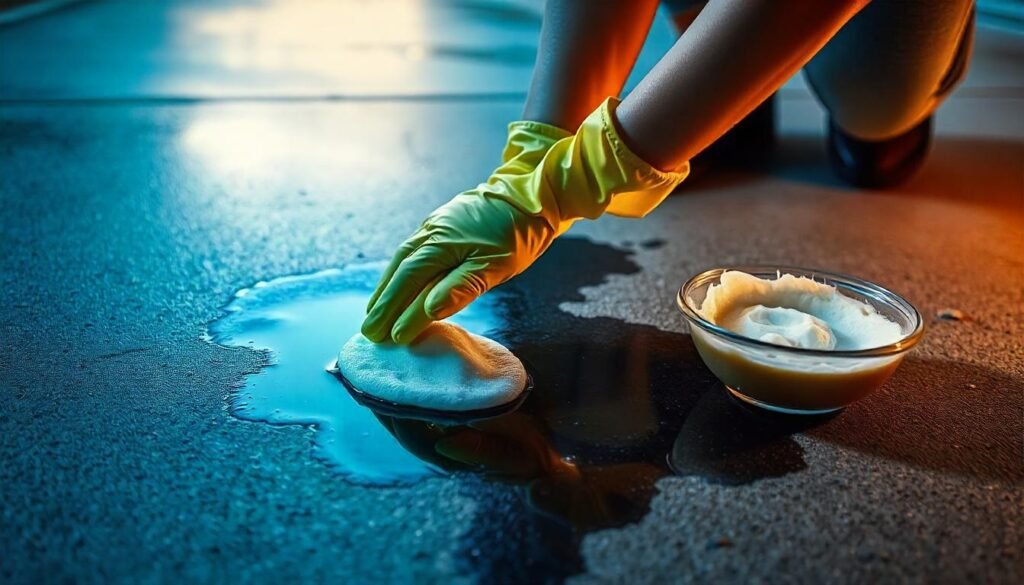
“7 Eliminate Powerful Oil Stains from Walls”
“7 Eliminate Powerful Oil Stains from Walls”
“Eliminate unsightly oil stains from your walls with these 7 powerful tips. Discover effective methods to restore your home’s appearance effortlessly.”


Introduction
Brief Overview of the Challenges of Removing Oil Stains from Walls
Oil stains on walls can be particularly stubborn and difficult to remove. They can penetrate deep into the surface, making it challenging to clean without the right techniques and products. Whether it’s from cooking splatters, greasy hands, or other sources, oil stains can leave unsightly marks that are tough to eliminate.
Explanation of the Importance of Using Effective Methods to Maintain Clean and Spotless Walls
Maintaining clean and spotless walls is essential for both aesthetic and health reasons. Effective cleaning methods ensure that oil stains are thoroughly removed, preventing potential damage and maintaining the overall appearance of your home. Using the right techniques can also protect your wall surfaces from damage and prolong their lifespan.

Tip 1: Baking Soda and Water Paste
Explanation of How Baking Soda Can Lift Oil Stains
Baking soda is a natural abrasive that can help lift oil stains from walls. It works by breaking down the oil and absorbing it, making it easier to clean.
Step-by-Step Instructions for Using This Method
- Mix Paste: Combine baking soda with a small amount of water to form a thick paste.
- Apply Paste: Spread the paste over the oil stain using a cloth or sponge.
- Let It Sit: Allow the paste to sit for at least 15 minutes to absorb the oil.
- Scrub: Gently scrub the stain with a soft brush or sponge.
- Wipe Clean: Wipe away the paste with a damp cloth and rinse the area with water.
Tips for Best Results
- For tough stains, repeat the process as needed.
- Ensure the area is well-ventilated when using baking soda.
Tip 2: Dish Soap and Warm Water
Benefits of Using Dish Soap and Warm Water for Oil Stain Removal
Dish soap is designed to cut through grease, making it an effective solution for oil stains. When combined with warm water, it can help to break down and lift the oil from the wall surface.
Detailed Process for Applying This Method
- Mix Solution: Mix a few drops of dish soap with warm water in a bucket.
- Apply Solution: Use a sponge or cloth to apply the soapy water to the oil stain.
- Scrub: Gently scrub the stain with a brush or sponge.
- Rinse: Rinse the area with clean water to remove any soap residue.
- Dry: Dry the area with a clean towel.
Recommendations for Different Wall Surfaces
- Painted Walls: Dish soap and warm water are safe for most painted surfaces.
- Wallpaper: Test a small area first to ensure the solution does not damage the wallpaper.

Tip 3: Cornstarch or Talcum Powder
How Cornstarch or Talcum Powder Can Absorb Oil Stains
Cornstarch and talcum powder are excellent absorbents that can draw oil out of the wall surface. They work by soaking up the oil, making it easier to clean.
Instructions for Using These Powders Effectively
- Sprinkle Powder: Generously sprinkle cornstarch or talcum powder over the oil stain.
- Let It Sit: Allow the powder to sit for several hours or overnight to absorb the oil.
- Brush Off: Brush off the powder with a soft brush or cloth.
- Wipe Clean: Wipe the area with a damp cloth to remove any remaining residue.
Tips for Ensuring Thorough Cleaning
- For best results, repeat the process if necessary.
- Ensure the area is dry before applying the powder.
Tip 4: Commercial Oil Stain Removers
Overview of Commercial Products Designed for Oil Stain Removal
There are various commercial oil stain removers available that are specifically formulated to tackle tough oil stains. These products often contain powerful cleaning agents that can break down and lift oil from wall surfaces.
Guidelines for Choosing the Right Product
- Read Labels: Choose a product that is suitable for your specific wall type.
- Check Reviews: Look for products with positive reviews and proven effectiveness.
- Follow Instructions: Always follow the manufacturer’s instructions for best results.
Application Tips for Maximum Effectiveness
- Apply the product directly to the oil stain.
- Allow it to sit for the recommended amount of time.
- Scrub and rinse the area as directed.
Tip 5: Vinegar and Water Solution
Explanation of How Vinegar Can Break Down Oil Stains
Vinegar is a natural cleaner that can help break down oil stains. Its acidic properties make it effective in dissolving grease and grime.
Step-by-Step Guide for Using This Method
- Mix Solution: Combine equal parts vinegar and water in a spray bottle.
- Apply Solution: Spray the vinegar solution onto the oil stain.
- Let It Sit: Allow the solution to sit for a few minutes to break down the oil.
- Scrub: Gently scrub the stain with a soft brush or sponge.
- Wipe Clean: Wipe away the solution with a damp cloth and rinse the area with water.
Safety Precautions to Consider
- Ventilation: Ensure the area is well-ventilated when using vinegar.
- Test First: Test the solution on a small, inconspicuous area to ensure it doesn’t damage the wall.

Tip 6: Hydrogen Peroxide and Baking Soda
Explanation of the Chemical Reaction That Helps Remove Oil Stains
Hydrogen peroxide and baking soda create a powerful cleaning combination. Hydrogen peroxide acts as a bleaching agent, breaking down the oil molecules, while baking soda helps to lift and absorb the oil from the wall surface.
Step-by-Step Guide for Using This Method
- Mix Solution: Combine 1/2 cup of baking soda with 1/4 cup of hydrogen peroxide to form a paste.
- Apply Paste: Spread the paste over the oil stain using a cloth or sponge.
- Let It Sit: Allow the paste to sit for at least 15 minutes to break down the oil.
- Scrub: Gently scrub the stain with a soft brush or sponge.
- Wipe Clean: Wipe away the paste with a damp cloth and rinse the area with water.
Safety Precautions to Consider
- Wear Gloves: Protect your hands by wearing gloves while handling hydrogen peroxide.
- Ventilation: Ensure the area is well-ventilated to avoid inhaling fumes.
- Test First: Test the solution on a small, inconspicuous area to ensure it doesn’t damage the wall.

Tip 7: Professional Cleaning Services
When to Consider Hiring Professional Cleaners
Hiring professional cleaners can be a great option when dealing with particularly stubborn or extensive oil stains that are difficult to remove with DIY methods. If you’ve tried multiple techniques without success, or if the stains cover a large area, it might be time to call in the experts.
Benefits of Professional Cleaning for Stubborn Oil Stains
- Expertise: Professional cleaners have the knowledge and experience to tackle tough stains effectively.
- Specialized Equipment: They use advanced cleaning tools and products that are not typically available to consumers.
- Time-Saving: Hiring professionals can save you time and effort, allowing you to focus on other tasks.
- Guaranteed Results: Many professional cleaning services offer guarantees, ensuring that the stains will be removed to your satisfaction.
How to Choose a Reputable Cleaning Service
- Research: Look for cleaning services with positive reviews and high ratings.
- Ask for Recommendations: Get referrals from friends, family, or neighbors who have used professional cleaners.
- Check Credentials: Ensure the company is licensed, insured, and has trained staff.
- Request Quotes: Get quotes from multiple services to compare prices and services offered.
- Ask About Methods: Inquire about the cleaning methods and products they use to ensure they are safe for your wall type.
Conclusion
Recap of the Seven Powerful Tips for Eliminating Oil Stains from Walls
- Baking Soda and Water Paste: A natural abrasive that lifts oil stains.
- Dish Soap and Warm Water: Effective for breaking down and removing oil.
- Cornstarch or Talcum Powder: Absorbs oil stains effectively.
- Commercial Oil Stain Removers: Specialized products for tough stains.
- Vinegar and Water Solution: Natural cleaner that breaks down oil.
- Hydrogen Peroxide and Baking Soda: Chemical reaction that lifts oil stains.
- Professional Cleaning Services: Expertise and specialized equipment for guaranteed results.
Encouragement to Try These Methods for Maintaining Clean and Spotless Walls
By trying these effective methods, you can maintain clean and spotless walls, free from unsightly oil stains. Each method offers unique benefits and can be tailored to suit your specific needs and wall type.
Final Thoughts on the Importance of Regular Wall Maintenance
Regular wall maintenance is essential for preserving the appearance and longevity of your walls. By addressing oil stains promptly and using the right cleaning techniques, you can ensure a clean, safe, and attractive living environment.





2 Comments
Pingback:
Pingback: